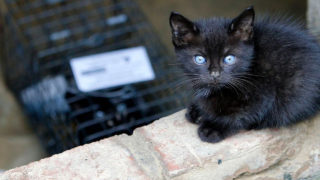Lately, scientific research is being exploited by fringe interests to promote the absurd notion that outdoor cats are the leading cause of bird species declines in the United States.
The most commonly cited was published in the online journal Nature Communications and funded by the Smithsonian Institution and the U.S. Fish and Wildlife Services (“The impact of free-ranging domestic cats on wildlife of the United States,” January 29, 2013 by Scott R. Loss, Tom Will, and Peter P. Marra).
News outlets have sensationalized coverage of this and similar “studies” by labeling cats as “serial killers” and using other exaggerated metaphors to manufacture a fake debate about outdoor cats and species decline that plays right into the fringe interests and bolsters their flawed arguments.
The common-sense and seldom-reported facts, however, are that habitat destruction, pollution, and climate change are far and away the greatest threats to birds and wildlife.
Bogus reports, propagated by the mass media, sidestep serious discussion on the real threats to birds and wildlife, and end up scapegoating cats.
The Smithsonian-funded study published in Nature Communications is not rigorous science.
It is a literature review that surveys a variety of unrelated, older studies and concocts a highly speculative conclusion that suits the researchers’ seemingly desperate anti-cat agenda. This speculative research is highly dangerousit is being used by opponents of outdoor cats and Trap-Neuter-Return (including the authors) to further an agenda to kill more cats and roll back decades of progress on TNR. And it is being spread unchecked by the media. Only a handful of reporters, including CNN’s Erin Burnett, have questioned the Nature Communications research. Burnett noted the ridiculously large margin of error the authors employed, deemed it “unacceptable,” and told her viewers, “When it comes to the danger of cats, it seems like they’re just telling tales.”
To assess the integrity of the Smithsonian study, Alley Cat Allies commissioned a respected, independent statistician, Gregory J. Matthews, PhD, of the University of Massachusetts at Amherst.
Dr. Matthews conducted a thorough review of the statistics and methodology used in the study and found major flaws that should have made the authors’ research unacceptable for publication. Some key insights from Dr. Matthews’ assessment:
- The authors looked at a number of previously published studies to make their case. The studies have a huge range in size, scope, and geography. Some were not peer reviewed. Some were decades old–one of the studies the authors used was published in 1930. They counted one study twice–a major error that was not picked up by peer reviewers.
- There was no use of a meta-analysis to normalize across all these very dissimilar studies. Use of a meta-analysis is common, and the authors failed to address why they did not use one. They also failed to acknowledge that each individual estimate itself has error.
- The authors used extrapolation where it was not warranted–often. They failed to account for variations in season, geography, or predation opportunity.
“If a student turned something like this in for a freshman statistics class, he would have failed the assignment,” Dr. Matthews relayed to Alley Cat Allies in an interview.
No one should be swayed by this junk science.
But such misinformation does confuse the issue about outdoor cats, and the authors know it. Indeed, they are doing nothing more than promoting cleverly veiled propaganda to promote their true agenda, which is mass killing of the millions of outdoor cats in the United States.
Here’s the real story: Trap-Neuter-Return remains the only effective approach for community cats.
Animal protection experts, individual caregivers, mayors, city councils, and county commissioners across the country are turning to TNR as the best response to community cats. By humanely trapping, neutering, vaccinating, and then returning outdoor cats to their natural environment, communities can end the breeding cycle, protect cats, and save taxpayer dollars.
Studies clearly show that TNR policies effectively reduce the size of outdoor cat colonies both immediately (with the removal and adoption of kittens and socialized cats) and over time (as the population stabilizes and the breeding cycle ends).
Supporters of catch and kill programs have spread misinformation in an effort to slow down the adoption of TNR policies. They have spread myths about outdoor cats’ health and their impact on the environment. They are desperately clinging to these myths in an attempt to cover up the truth–that catch and kill is extremely cruel, ineffective, and wasteful. Decades of failed catch and kill policies prove that it does not even permanently reduce outdoor cat colonies, and it wastes taxpayer dollars that should be used to protect animals.
Trap-Neuter-Return is safe for our communities. It’s humane. And it’s effective.
Because TNR is proven to stabilize and reduce cat populations over time, it is now the gold standard for community cat management in the United States. Hundreds of communities have passed laws or enacted policies supporting the practice of TNR and have thriving TNR programs. Animal control and public health officials have endorsed TNR, calling it common sense and effective because it reduces calls to municipal agencies, keeps cats out of shelters, improves the wellbeing of cats and communities, and saves tax dollars.
Junk science gets cats killed.
It’s time for the national media to start reporting on the thinly-veiled agenda of anti-cat researchers. Their proposed “solution” really only endorses the endless cycle of mass killing of cats.

